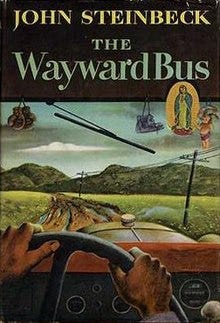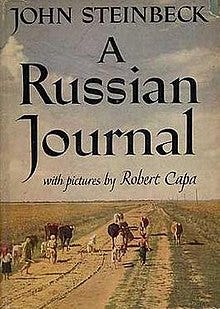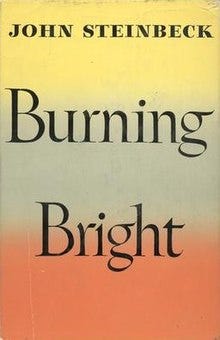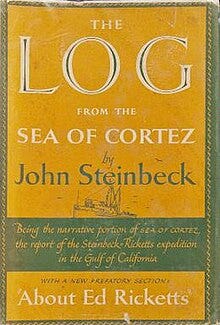The Steinbeck Review #6
The Wayward Bus | A Russian Journal | Burning Bright | The Log from the Sea of Cortez
Welcome to Beyond the Bookshelf, a community of readers and writers sharing unique perspectives on life and literature through thought-provoking essays, captivating interviews, and influential books as we explore the challenges of life's transformative journey.
Housekeeping
Before getting into this week’s article, I wanted to touch base on a couple of items. First, welcome to all the new subscribers. It is amazing to see how the community is growing. One of my greatest joys is engaging with readers so please feel free to comment and add to the discussion.
Second, this week’s article is part of a series called The Steinbeck Review. During 2024, I am reading the complete works of John Steinbeck and writing a short synopsis of each. These review articles only happen once per month, so if this isn’t your cup of tea, no worries. I try to switch things up each week so there is some variety in the content while maintaining some consistent themes across all the writing.
Finally, between now and the end of July my life is pretty chaotic. I am retiring from the Navy next month so my work days are busy training the person who is coming in behind me, we have lots of preps going on for the retirement ceremony, and family and friends will be coming into town for a visit, and then we are taking a family trip to Italy to celebrate. All of this is to say that over the next few weeks, I have invited a few other writers to provide some guest posts, and I will be reworking a couple of older articles from the archives (when I had about 20 readers).
Starting in August, this newsletter will be my full-time vocation and I have some great things planned out. So stick with me through these busy weeks of summer and transition. I am grateful to have you all along for the adventure.
Dear Friends,
Between 1947 and 1952, John Steinbeck experienced significant changes in his life marked by literary successes, political activism, and personal challenges.
In 1947, he was at the height of his literary fame. He had published several acclaimed works, including Of Mice and Men (1937) and The Grapes of Wrath (1939), which earned him the Pulitzer Prize for Fiction in 1940. During this period, Steinbeck faced ongoing battles with his inner demons, such as depression and self-doubt. Despite his literary achievements and outward success, he remained plagued by existential unease, wrestling with questions of purpose and meaning in his life and work.
Beyond his literary pursuits, Steinbeck remained politically active in his advocacy for social justice and labor rights. He maintained an association with progressive causes and organizations, often using his platform to illuminate issues affecting marginalized communities. Steinbeck's commitment to social activism was evident in his writing and public statements, cementing his reputation as a voice for the disenfranchised.
In 1949, Steinbeck married Elaine Scott, his third wife. Their union marked a period of stability and companionship for Steinbeck, providing him with emotional support as he navigated the challenges of fame and public scrutiny.
The period between 1947 and 1952 was a time of triumph and tribulation for John Steinbeck. Despite facing professional challenges and personal struggles, he continued to produce thought-provoking and influential literature that resonated with audiences worldwide. His commitment to social justice and his unwavering dedication to his craft ensured that Steinbeck's legacy would endure long after his passing.
“It seems to me that young people have lost their faith in America. Our ancestors had faith.”
The Wayward Bus, published in 1947, explores the transformative journeys of its characters amidst the backdrop of a fateful bus ride. Set in post-World War II America, the novel examines the lives of a diverse group of individuals, each struggling and striving for personal redemption. Through Steinbeck's masterful storytelling, they navigate a tumultuous journey, confronting challenges and undergoing profound change.
At the heart of the narrative is Juan, the Mexican-American bus driver whose life becomes entwined with those of his passengers. He is resilient in the face of adversity, navigating the complexities of racial prejudice and economic hardship. As the journey unfolds, Juan undergoes a metamorphosis, confronting his insecurities and finding solace in the companionship of his fellow travelers. Juan discovers empathy and solidarity through interactions with them, forging genuine connections that transcend race and class barriers.
Among the passengers is Alice, a disillusioned actress seeking refuge from the pressures of fame. Stripped of her glamorous façade, she embarks on a journey of self-discovery, confronting her issues and embracing the raw authenticity of her true self. Through her encounters with the other passengers, Alice finds liberation from the constraints of societal expectations, reclaiming her agency and embracing a newfound sense of purpose.
Equally compelling is Norma, a young woman burdened by the weight of her past mistakes. Haunted by guilt and shame, she struggles with her sense of worthiness, attempting to find meaning amidst the wreckage of her life. Eventually, Norma discovers the power of forgiveness and self-acceptance, shedding the shackles of her past and embracing the possibility of a brighter future.
Camille is a mysterious hitchhiker whose enigmatic presence casts a shadow over the bus journey. With her mysterious demeanor and cryptic utterances, she serves as a catalyst for introspection, challenging the passengers to confront their deepest fears and desires. Through her unique brand of wisdom, Camille imparts profound insights into the nature of human existence, creating ripples that reverberate throughout the journey.
As the bus hurtles towards its destination, obstacles threaten its progress, from mechanical breakdowns to unforeseen detours. These challenges force the characters to face internal and external trials that test their resilience and resolve. They emerge stronger and more resilient than before.
Facing their limitations and rising above the constraints of their circumstances, they forge bonds that help them defy the odds and seize control of their destinies. Steinbeck's richly drawn characters and evocative prose invite us to explore the human condition from uncertainty and despair to hope and renewal.
“Sometimes it seems that the leaders of nations are little boys with chips on their shoulders, daring each other to knock them off.”
A Russian Journal chronicles Steinbeck’s travels through the Soviet Union in 1947, offering insight into the experiences of the Russian people in the post-World War II Soviet Union. His keen observations and empathetic storytelling immerse the reader in the lives of ordinary Soviet citizens, each coping with the challenges of a society in transition. From the bustling streets of Moscow to the idyllic countryside of Georgia, the narrative explains the resilience of the human spirit in the face of adversity.
Central to the narrative are Steinbeck and his companion, the acclaimed war photographer Robert Capa, whose trip provides a lens through which to view the social and political landscape of Soviet Russia. Steinbeck and Capa encounter many Soviet citizens, each with their own stories. From factory workers to collective farmers, they share the struggles and triumphs of ordinary Russians.
Ivan is a collective farmer in the rural village of Sukhumi. Despite facing immense hardships in the war's wake, he remains committed to his land and community. Ivan’s resilience and spirit are typical of the Russian people, who refuse to be broken by their challenges. As Steinbeck reflects on Ivan's plight, he marvels at the capacity of ordinary individuals to find hope and purpose when surrounded by chaos.
Equally captivating is Tatiana, a young factory worker performing grueling steel production work. She is one of the vast Soviet proletariat whose labor fuels the engine of the nation's industrialization. Despite the harsh conditions of her work, she enjoys the camaraderie of her fellow workers and the sense of purpose that comes from contributing to the collective effort. Tatiana defies the dehumanizing effects of industrialization, finding meaning in solidarity and community.
As Steinbeck and Capa seek to understand Soviet society, they encounter many individuals shaped by the larger forces of history and ideology. From party officials to dissidents, they witnessed the complexities of Soviet life, where loyalty and dissent existed side by side. Amidst the ideological divides and political tensions, Steinbeck finds moments of genuine connection and humanity, universal bonds that unite us.
Steinbeck and Capa undergo transformative experiences that challenge their preconceptions and broaden their perspectives. Their interactions with the people they encounter force them to confront their biases and assumptions, resulting in a more profound understanding.
Steinbeck's vivid prose and Capa's evocative photography transport us to a world where the human spirit triumphs over the forces of history and ideology. In the lives of ordinary Soviet citizens, we find inspiration and hope, evidence of the human spirit’s ability to overcome even the most daunting of trials.
“I've given you everything a friend can give, even contempt, and that's the hardest thing of all.”
Burning Bright, published in 1950, is a powerful foray into the human condition. Set against the backdrop of a circus traveling through post-World War II America, the novel follows the intertwined lives of its characters, each confronting their struggles and searching for meaning.
At the heart of the narrative is Joe Saul, the circus manager whose iron will and fierce determination mask a deep-seated sense of insecurity and longing. Joe Saul faces obstacles that test his resolve and force him to confront his inner turmoil while he manages the circus and its motley crew of performers. From financial struggles to interpersonal conflicts, Joe's journey is marked by moments of crisis and introspection as he feels the weight of his responsibilities and the uncertainty of the future.
Mordeen, the lion tamer whose fierce exterior belies a profound vulnerability, is haunted by the trauma of his past and is struggling to find his place in the world. He embarks on a quest of self-discovery that takes him to the edge of his sanity. The dangers of his profession and the demons of his psyche force Mordeen to undergo a profound metamorphosis, shedding the layers of fear and self-doubt that have held him captive. Through courage and self-sacrifice, he emerges from his trials as a changed man, embracing a newfound purpose and inner strength.
Pop is the elderly clown whose cheerful appearance hides a lifetime of regrets and missed opportunities. He seeks redemption amidst his despair as he comes to terms with old age and the specter of mortality. He discovers unexpected moments of grace, finding solace in the simple pleasures of friendship and human connection. Pop learns that it is never too late to seek forgiveness and embrace a brighter future.
Traveling from town to town, the characters face mechanical failures and personal betrayals, confronting the harsh realities of life and the fragility of human existence. Somehow, they find the strength to carry on, drawing upon the bonds of friendship to overcome adversity.
“One who was born by the ocean or has associated with it cannot ever be quite content away from it for very long.”
The Log from the Sea of Cortez, published in 1951, is an autobiographical account of Steinbeck and his friends' transformative experiences as they embark on a marine expedition along the coast of the Sea of Cortez. His mastery of prose is on display as he transports the reader into the world of the expedition crew as they confront the challenges of scientific exploration and mysteries of the natural world.
Steinbeck and his close friend, the marine biologist Ed Ricketts, whose shared passion for marine biology catalyzes the expedition sail aboard the Western Flyer, a small fishing boat converted for scientific research. They assemble a crew with unique skills and perspectives, from the seasoned fishermen to the aspiring scientists, embarking on an adventure that will forever alter their understanding of the world around them.
As Steinbeck immerses himself in the intricacies of marine biology and the wonders of the Sea of Cortez, he is profoundly moved by the beauty and complexity of nature. His interactions with Ricketts and the other crew members deepen his appreciation for the interconnectedness of all living things and the fragility of the ecosystems that sustain them. As he reflects on the expedition in his journal entries, Steinbeck thinks deeply about the existential questions of life, death, and the meaning of existence, ultimately emerging from the journey with a renewed sense of purpose and perspective.
Ed Ricketts, whose pioneering revolutionized the field of marine biology, inspired generations of scientists. His insatiable spirit of inquiry and discovery drove the scientific exploration of the expedition and allowed him to share his knowledge with his fellow crew members. However, Ricketts faces his existential doubts and eventually finds comfort in the bonds of friendship, the shared pursuit of knowledge, and the act of scientific inquiry itself.
As the expedition progresses, the crew is confronted with challenges that test their resilience, including encounters with unpredictable weather. They must come together, using their collective skills and resourcefulness to navigate the dangers of the sea. They also find moments of beauty and wonder as they witness the myriad forms of life that inhabit the waters of the Sea of Cortez. Their shared experience forms bonds of camaraderie that transcend the boundaries of language and culture.
Scientific exploration and the enduring spirit of curiosity continue to drive human inquiry. Here, we observe the wonders of the natural world and the profound impact they can have on the human soul. In the waters of the Sea of Cortez, Steinbeck and Ricketts find a wealth of scientific knowledge and a deeper understanding of themselves and their place in the universe.
I would love to hear from you in the comments. Have you read anything by Steinbeck? What was your impression? Any favorites?
Until next month…
All opinions in this essay are my own. Any biographical or factual information was obtained through the references below:
Mad at the World: A Life of John Steinbeck by William Souder
John Steinbeck: A Biography by Jay Parini
John Steinbeck, Writer: A Biography by Jackson Benson
Steinbeck: A Life in Letters edited by Elaine Steinbeck and Robert Wallsten
Writing Beyond the Bookshelf is a labor of love. If you have the means and desire to support my writing financially, a couple of options are available. Regardless of how you support my work, as a free subscriber or paid, I am grateful that you have chosen to be a part of this community of readers and writers exploring the relationship between life and literature.









I'm drawn to the developmental opportunities highlighted in your synopsis of The Wayward Bus.
We experience growth and development when we uncover our assumptions and beliefs about how the world works and see them as objects rather than being subject to them.
As you describe the characters in this book, I can't help but notice how they seem to challenge each others' assumptions. They help each other see what was unseen before.
I know Steinbeck through THE GRAPES OF WRATH, a vivid memory from the distant past, and TRAVELS WITH CHARLEY, which I discovered in the first flush of love for my first dog, mistakenly thinking that Charley would be front and center. Your post today leaves me with a question: Did this incorrigibly restless soul ever write a book that did not involve some kind of journey? His collaboration with Capa (never knew of it) suggests a Russian bookend to TRAVELS WITH CHARLEY, in which he wrote, “A journey is a person in itself; no two are alike…. We find after years of struggle that we do not take a trip; a trip takes us.”